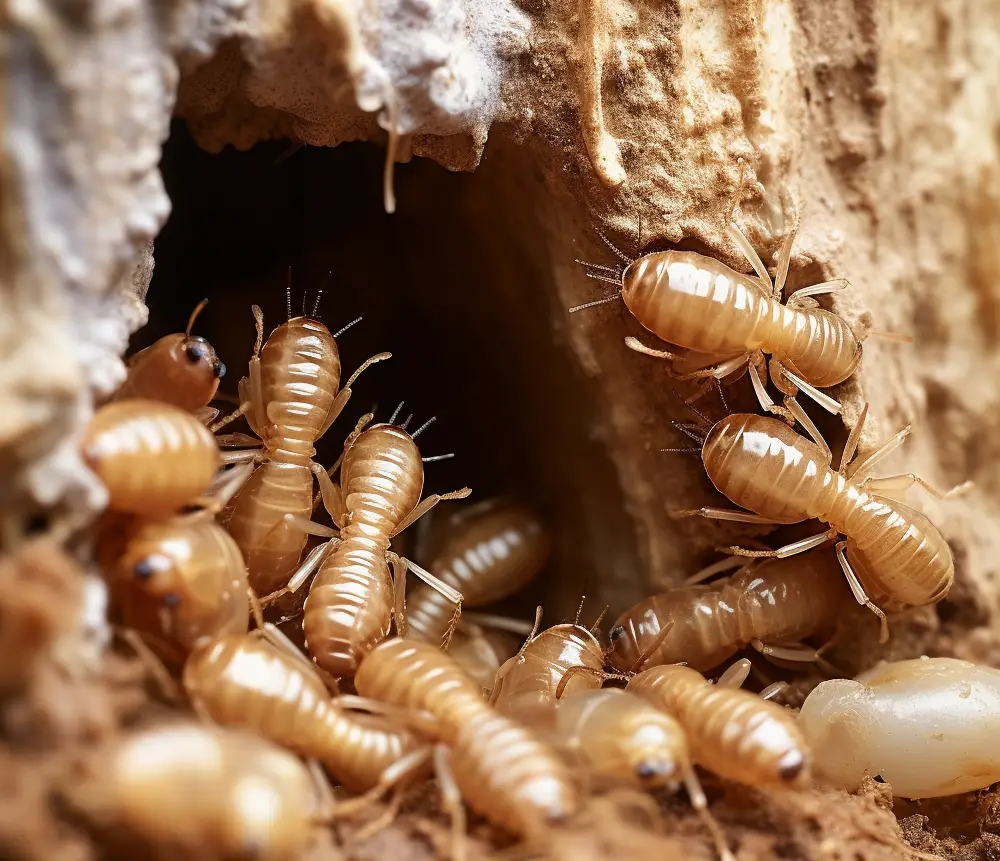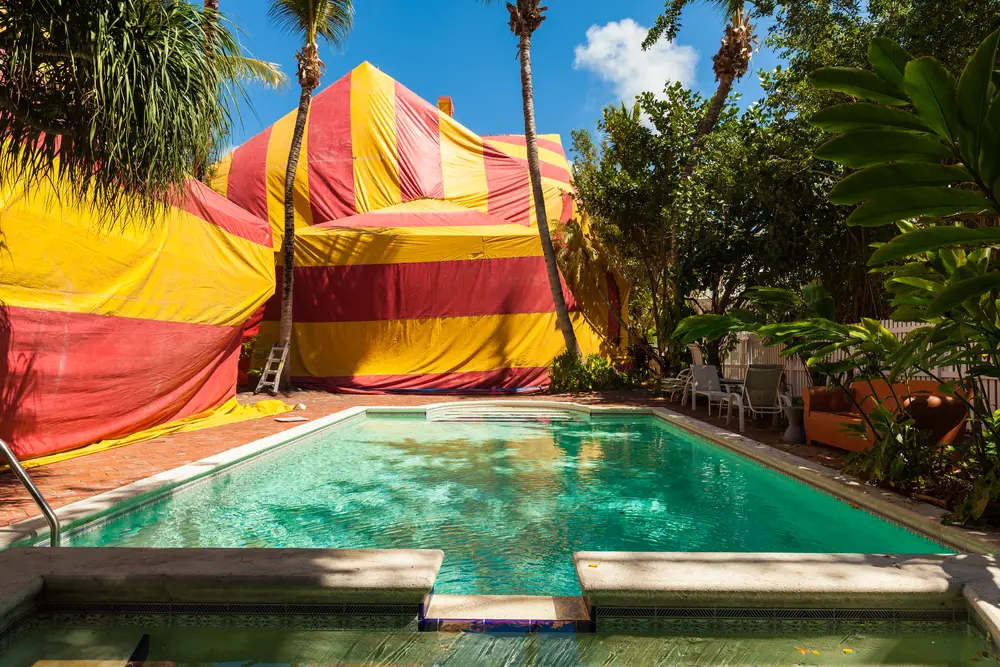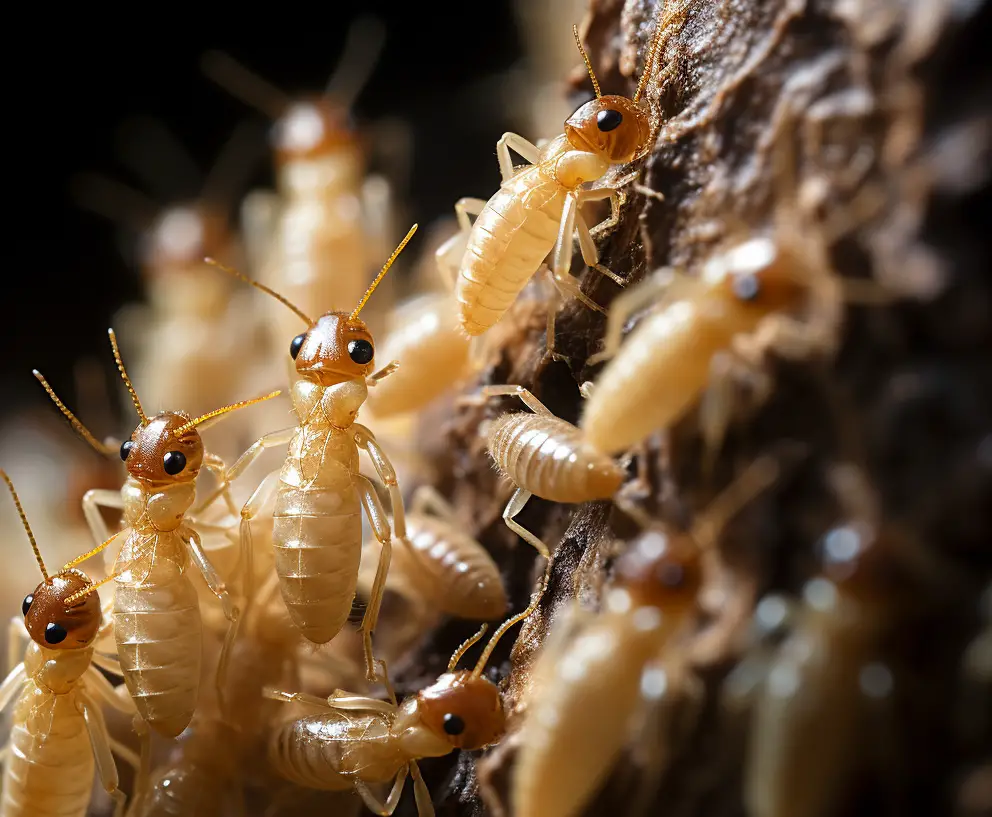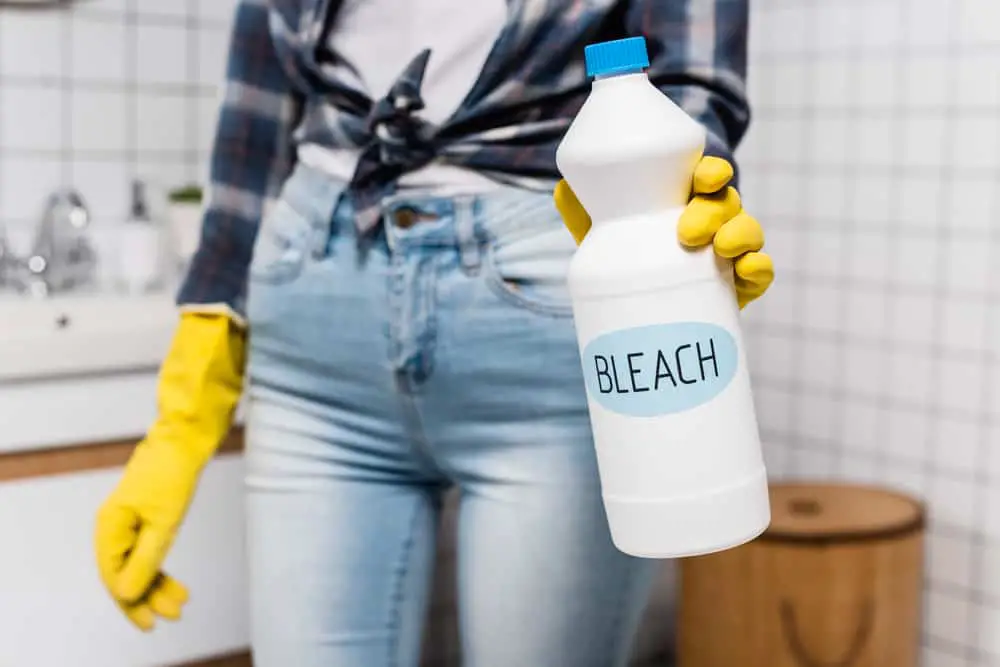Bleach is known for its strong properties as a cleaning agent, but its potential as a termite eradicator may not be as widely understood.
In this article, we will explore whether bleach is an effective method for tackling termite infestations and discuss the pros and cons of using bleach for this purpose.
Quick Answer:
Bleach can kill termites on contact but is not a long-term solution for infestations. It won’t reach termites deep in wood or soil and may be harmful to the environment. Professional treatments are advised for effective control.
Understanding Termites
Termite Biology
Termites are social insects that live in colonies, which are organized into castes, including workers, soldiers, and reproductive individuals called alates.
They feed primarily on cellulose found in materials like wood and plants, breaking it down through a process involving the symbiotic microorganisms in their gut.
Subterranean termite colonies are the most common type, with their nests typically found underground.
These termites build mud tubes, which allow them to move between their nest and food sources while maintaining a moist environment. Moisture is crucial for their survival, as they require a high level of humidity to keep from desiccating.

On the other hand, drywood termites do not require contact with soil, as they obtain their needed moisture from the wood they consume. As a result, they can infest various wooden structures, often causing extensive damage.
Types of Termites
Termites can be grouped into two main categories:
Subterranean Termites: These types of termites create underground colonies and require direct contact with the soil. They build distinctive tunnels, called mud tubes, to reach food sources and protect themselves from open air.
Some common examples include:
- Eastern Subterranean Termites
- Formosan Subterranean Termites
- Western Subterranean Termites
Drywood Termites: Unlike subterranean termites, drywood termites do not require contact with the soil and can establish colonies within wooden structures. They obtain the necessary moisture from the wood they consume.
Examples of drywood termites include:
- Western Drywood Termites
- Southeastern Drywood Termites
- Desert Drywood Termites
Bleach and Its Properties
Bleach is a widely used household cleaning agent and disinfectant known for its powerful ability to eliminate stains, kill bacteria, and break down microorganisms. The main active ingredient in most bleach products, including Clorox bleach and laundry bleach, is sodium hypochlorite.
This chemical compound is a strong oxidizer, which makes it highly effective in destroying various harmful organisms and contaminants.
Sodium hypochlorite is produced by mixing chlorine gas with a sodium hydroxide solution. The resulting chemical compound is a pale yellow liquid with a strong chlorine smell.
In varying concentrations, sodium hypochlorite can serve multiple purposes, such as sanitizing drinking water, disinfecting surfaces, and treating wastewater. Its versatility, along with its affordability, has made bleach a popular choice among consumers and industries alike.
When it comes to household use, bleach is typically diluted to a concentration of about 5-8% sodium hypochlorite. This concentration is ideal for general cleaning and sanitation purposes.
However, be cautious when using bleach, as it can cause skin irritation, eye irritation, or respiratory issues if not handled properly. Bleach should never be mixed with other cleaning products, as this could create hazardous chemical reactions.
It is important to note that while bleach is effective in eliminating a wide range of germs, bacteria, and fungi, its overall efficiency in dealing with insects, such as termites, is still a topic of debate.
The ability of bleach to kill termites would heavily depend on factors like proper application and the specific type of termite being targeted.
Bleach as a Termite Treatment
Mechanism of action
Bleach has been known to kill termites due to its strong oxidizing properties. Its active ingredient, sodium hypochlorite, affects the termites in two main ways:
- Exoskeleton degradation: The bleach solution can break down the termites’ exoskeleton, causing them to dehydrate and eventually die.
- Digestive system damage: The high sodium content in bleach can also disrupt the termites’ digestive system, ultimately leading to their death.
Practical Application
Using bleach to kill termites can be done by following these simple steps:
- Prepare the mixture: Mix bleach with water in the appropriate ratio (typically 1 part bleach to 10 parts water) to create a diluted bleach solution.
- Transfer to a spray bottle: Pour the mixture into a spray bottle for easy application.
- Apply on wooden surfaces: Spray the bleach solution on wooden surfaces infested with termites, ensuring to cover all areas where termites could hide.
- Repeat if necessary: Monitor the treated area and repeat the process if termites are still present.
While bleach can be an effective termite treatment, it might not be the best option for long-term prevention and protection.
Professional termite treatments and regular inspections are recommended for a more comprehensive solution against termite infestations.
Efficacy and Limitations
Effectiveness
Bleach can be an effective method to kill termites on contact. Termites are susceptible to the toxic chemicals present in bleach, which can quickly disrupt their nervous systems and cause them to die.
Moreover, bleach can help break down the cellulose present in the wood, making it less appealing to termites.
It’s important to note, however, that bleach’s effectiveness against termites is limited to the areas it directly contacts. Termites typically hide within walls, floors, and other hard-to-reach places in a home, where applying bleach may not be feasible.
Potential Drawbacks
Although bleach can be effective in exterminating termites, it also has some limitations that make it less ideal for long-term control of a termite infestation:
- Toxicity: Bleach is harmful not only to termites but also to humans and pets. Direct contact with bleach or inhaling its fumes can cause irritation and lead to health problems.
- Difficulty in reaching infested areas: Termites often reside deep within walls, floorings, and other wooden structures, making it challenging to apply bleach to the affected areas. This limitation reduces the overall effectiveness of bleach as a termite control solution.
- Damaging wooden structures: While bleach can help deter termites by breaking down cellulose, extended exposure to bleach can weaken and damage wooden surfaces, causing additional problems to your property.
- Temporary solution: Using bleach to kill termites does not guarantee the prevention of a new infestation. Termites can return if the source of the problem is not addressed.
Safety Measures and Precautions
When using bleach to kill termites, it’s important to take certain safety measures and precautions to protect yourself and others from the potential risks associated with bleach.
Firstly, bleach is a toxic substance, and if not handled properly, can cause harm. Therefore, it is necessary to wear rubber gloves and safety goggles when handling or applying bleach. These will protect your skin and eyes from any accidental contact with the bleach.
Next, make sure to use bleach in a well-ventilated area. Bleach releases fumes that can be harmful when inhaled in large quantities. Open windows and doors when possible to allow proper ventilation. If working in an enclosed space, consider using a fan to circulate fresh air.
It’s also crucial to never mix bleach with other cleaning agents, especially ammonia-based products. This combination can create toxic chloramine gas, which can cause respiratory issues and other health problems.
Additionally, bleach can damage certain surfaces and materials. To prevent damage to your home or belongings, test a small, inconspicuous area before applying bleach to a larger area.
When disposing of bleach or containers that held bleach, always follow local regulations and guidelines. This ensures that the bleach is properly disposed of without harming the environment or posing a risk to others.
Alternative Termite Treatment Methods
While bleach may be a potential solution for termite infestations, there are several other methods to consider for effective termite treatment.
Professional Pest Control Services

Professional pest control services offer a range of treatments for termites, including chemical treatments, baiting systems, and fumigation.
Many homeowners prefer using professional services for termite control as they possess the necessary expertise and equipment.
- Chemical treatments: These treatments involve applying chemicals to the soil around the home to create a barrier that termites cannot cross. The chemicals also help in eliminating the existing termite colonies.
- Baiting systems: Termite baits, containing a slow-acting toxicant, are placed strategically in areas with suspected termite activity. The termites take the bait back to their colony, gradually reducing the population.
- Fumigation: In severe cases, fumigation may be the best solution. This process involves heavy-duty equipment which releases a gas to eliminate termites.
DIY Alternatives
If you prefer to handle your termite problem without professional assistance, there are several DIY solutions you can try. Some common options include borax, termite traps, and natural remedies:
- Borax: Mixing borax with water or using borax-based products can be an effective DIY treatment for termite infestations. Apply it to the affected areas or use it in bait stations to target termites.
- Bates and Traps: Set up termite bait stations and traps around your home, designed to attract the insects and poison them upon consumption.
- Natural Remedies: Physical barriers, such as installing a metal shield in the foundation, can help to keep termites away from your property. Additionally, some people suggest using natural substances like orange oil as a home remedy for termites, although the effectiveness of these treatments is debatable.
Preventative Measures and Maintenance
To keep termites at bay and maintain the integrity of your property, you can take several preventive measures.
First and foremost, remove any sources of food for termites, such as woodpiles, rotting wood, and cellulose materials. Ensure proper storage and avoid direct ground contact to deter termite activity.
Sealing potential entry points can be a great help in reducing the risk of infestations. Regularly inspect your home’s foundation for cracks and holes, and seal any openings you find.
Ventilation plays a vital role in maintaining humidity levels; installing vents and using dehumidifiers can help keep your home dry, making it less attractive to termites.
When it comes to maintenance, focus on scheduling regular inspections by a professional pest control expert. This way, you can detect termite colonies in their early stages before they cause substantial damage.
In addition, monitoring stations can help identify termite activity and the effectiveness of treatments.
Remember, proper drainage management is crucial. Ensure that gutters and downspouts are functioning correctly and that water is directed away from the building’s foundation. This can help preserve the soil and wood conditions, making it harder for termites to thrive.
When to Seek Professional Help
If you suspect a termite issue in your home, it’s important to seek professional help as soon as possible. Termites can cause significant structural damage to your property if left untreated.
Professional pest control services can provide a thorough inspection, identify the extent of the problem, and offer the most effective options for treating termites.

A professional inspection can help uncover hidden colonies that may be beyond the reach of DIY measures, like bleach. This is crucial because treating only a portion of the infestation will not solve the problem.
Moreover, using bleach might not be suitable or safe for all situations, as it can cause damage to certain surfaces and materials.
In terms of options for treating termites, professional services have access to a range of treatments that can effectively eradicate termite infestations. These methods include baiting systems, soil treatments, and fumigation.
While their costs may vary, investing in professional pest control can ultimately save homeowners from costly repairs and property damage caused by termites in the long run.
When evaluating termite treatment costs, it’s essential to weigh the expenses against the potential damage termites can cause to your property. In most cases, the cost of professional help is far less than the financial impact of leaving a termite infestation untreated.
It’s also important to consider that certain types of termite treatments may require specialized equipment and expertise that only professional exterminators possess.


